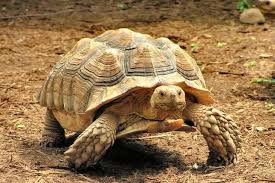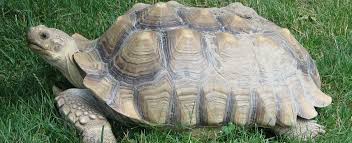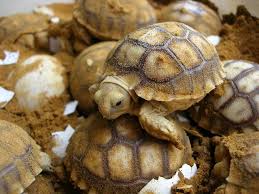
African spurred tortoise
(Goechelone sulcata)

The African spurred tortoise, also called the sulcata tortoise, is a species of tortoise, which inhabits the southern edge of the Sahara desert, in northern Africa. It is the third-largest species of tortoise in the world, the largest species of mainland tortoise, and the only species in the genus Centrochelys.
Conservation status
Vulnerable
Scientific classification |
|
| Kingdom: | Animalia |
| Phylum: | Chordata |
| Class: | Sauropsida |
| Order: | Testudines |
| Family: | Testudinidae |
| Genus: | Centrochelys |
| Specie: | Centrochelys sulcata |
Description

C. sulcata is the third-largest species of tortoise in the world after the Galapagos tortoise, and Aldabra giant tortoise, and the largest of the mainland tortoises. Adults can reach 83 cm (33 in) and can weigh 105 kg (231 lb). They grow from hatchling size (2-3 in) very quickly, reaching 6-10 in (15-25 cm) within the first few years of their lives. The lifespan of an African spurred tortoise is about 50-150 years, though they can live much longer. (The oldest in captivity is 54 years, located in the Giza Zoological Gardens, Egypt, 1986.)
Range and habitat

The African spurred tortoise is native to the Sahara Desert and the Sahel, a transitional ecoregion of semiarid grasslands, savannas, and thorn shrublands found in the countries of Burkina Faso, Chad, Eritrea, Ethiopia, Mali, Mauritania, Nigeria, Senegal, and Sudan In these arid regions, the tortoise excavates burrows in the ground to get to areas with higher moisture levels, and spends the hottest part of the day in these burrows. This is known as aestivation. Burrows may average 30 inches in depth; some dig tunnel systems extending 10 feet or more underground.
Diet
Sulcata tortoises are herbivores. Primarily, their diets consist of many types of grasses and plants, high in fiber and very low in protein. Feeding of fruit should be avoided.Breeding

Copulation takes place right after the rainy season, during the months from September through November. Males combat each other for breeding rights with the females and are vocal during copulation. Sixty days after mating, the female begins to roam looking for suitable nesting sites. For five to fifteen days, four or five nests may be excavated before she selects the perfect location in which the eggs will be laid.
Loose soil is kicked out of the depression, and the female may frequently urinate into the depression. Once it reaches about two feet (60 cm) in diameter and 3-6 in (7-14 cm) deep, a further depression, measuring some eight inches (20 cm) across and in depth, will be dug out towards the back of the original depression. The work of digging the nest may take up to five hours; the speed with which it is dug seems to be dependent upon the relative hardness of the ground. It usually takes place when the ambient air temperature is at least 78 °F (27 °C). Once the nest is dug, the female begins to lay an egg every three minutes. Clutches may contain 15-30 or more eggs. After the eggs are laid, the female fills in the nest, taking an hour or more to fully cover them all. Incubation should be 86 to 88 °F, and will take from 90 to 120 days.
Zoológico de Vallarta A. C.
Leave your comments, your opinion is important to us

